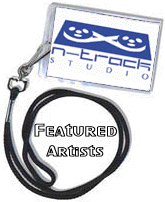AUGUST 2002


The Five W
![]() Where:
Chicago, Illinois
- USA
Where:
Chicago, Illinois
- USA
![]() Who:
Who:
Tim Moberly
Randy Flones
Pete Pecoraro
![]() When:
NA
When:
NA
![]() Why:
NA
Why:
NA
![]() What:
Rock
What:
Rock
![]() In
Short:
In
Short:
Influences:
Counting Crows, REM.
Albums:
Close
Enough
On
Location
Bridges
To Burn
|
The Vinyl Goods by Alessandro De Murtas Featured Songs: She's the One #note:Start with 2-guitars, bass and drums. Add a few guitar leads and harmonies, and you've got our entry for Pop Rock 101. Bridges to Burn #note: Song about those times when you have to cut your losses, move on, and not turn back. Happily Ever After #note: Baseball, hot dogs, apple pie and Chevrolet. An American story with a fairy tale theme. Strike While the Iron is Hot #note: Dylan-esque lyrics permeate this track about a steamy encounter. [..] "The Vinyl Goods are from the Chicago, Illinois area (USA). We've been playing together for 10 years and have produced several recordings over the years. We are a traditional "Americana" rock band consisting of guitars, bass, drums, and harmonies. Our style can best be described as a cross between REM and the Beatles. We have recorded albums using several different technologies. These include quarter-inch 8-track analog tape, HiFi VCR, 2-inch 24-track analog tape, and now with N-track Studio". Our new CD, "Bridges To Burn", is our first legitimate recording effort using N-Track.
|
What's Being Cooked Up?
| Featured Artist of the Month
- Comments and suggestions are
welcome. Are you an n-Track Studio's User? Would like to be reviewed? Send email to alex@n-track.com, reporting as much info as you can. Also including your recording equipment, procedures, tips & tricks for advantage of all the n-Track Studio's users. |
![]() Work
in Progress
Work
in Progress